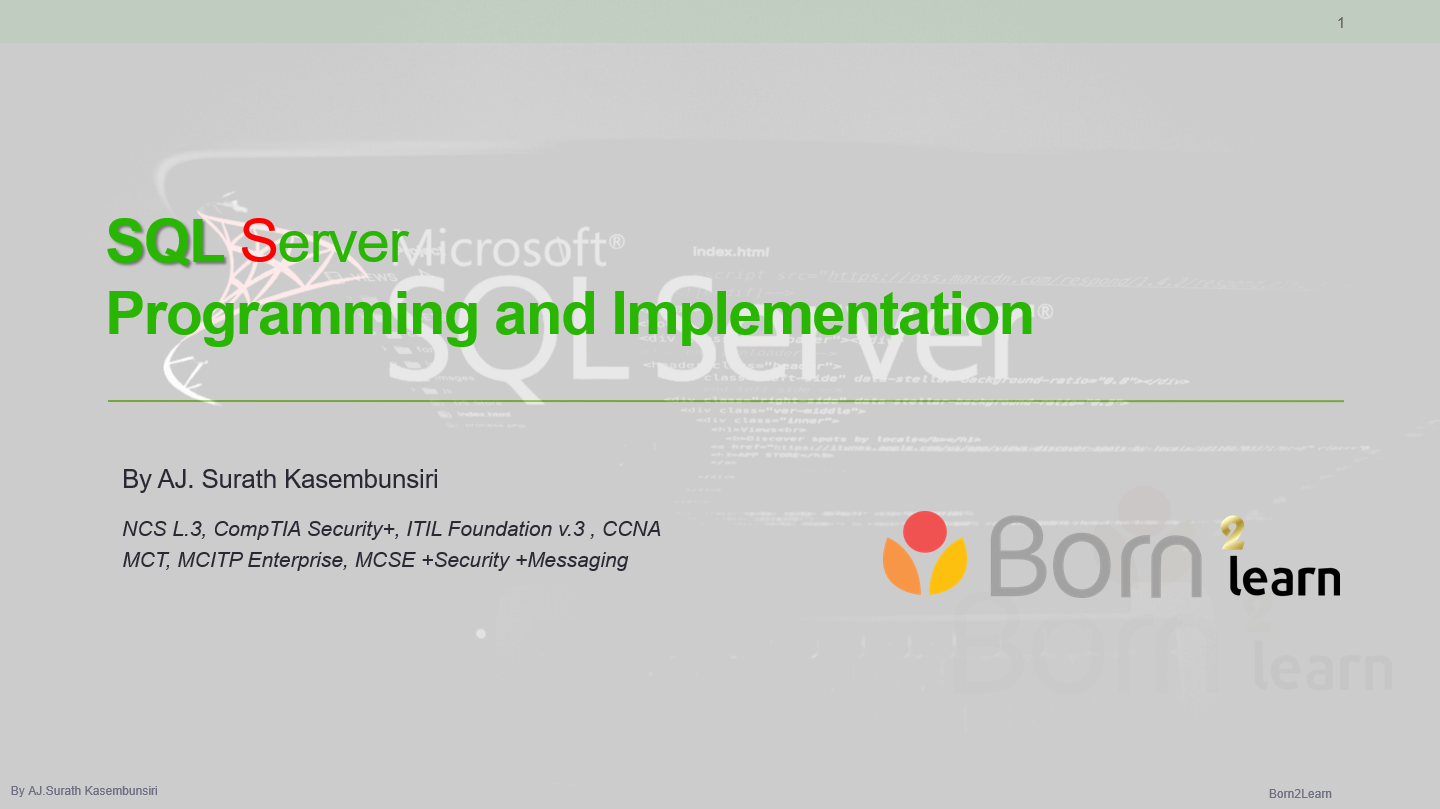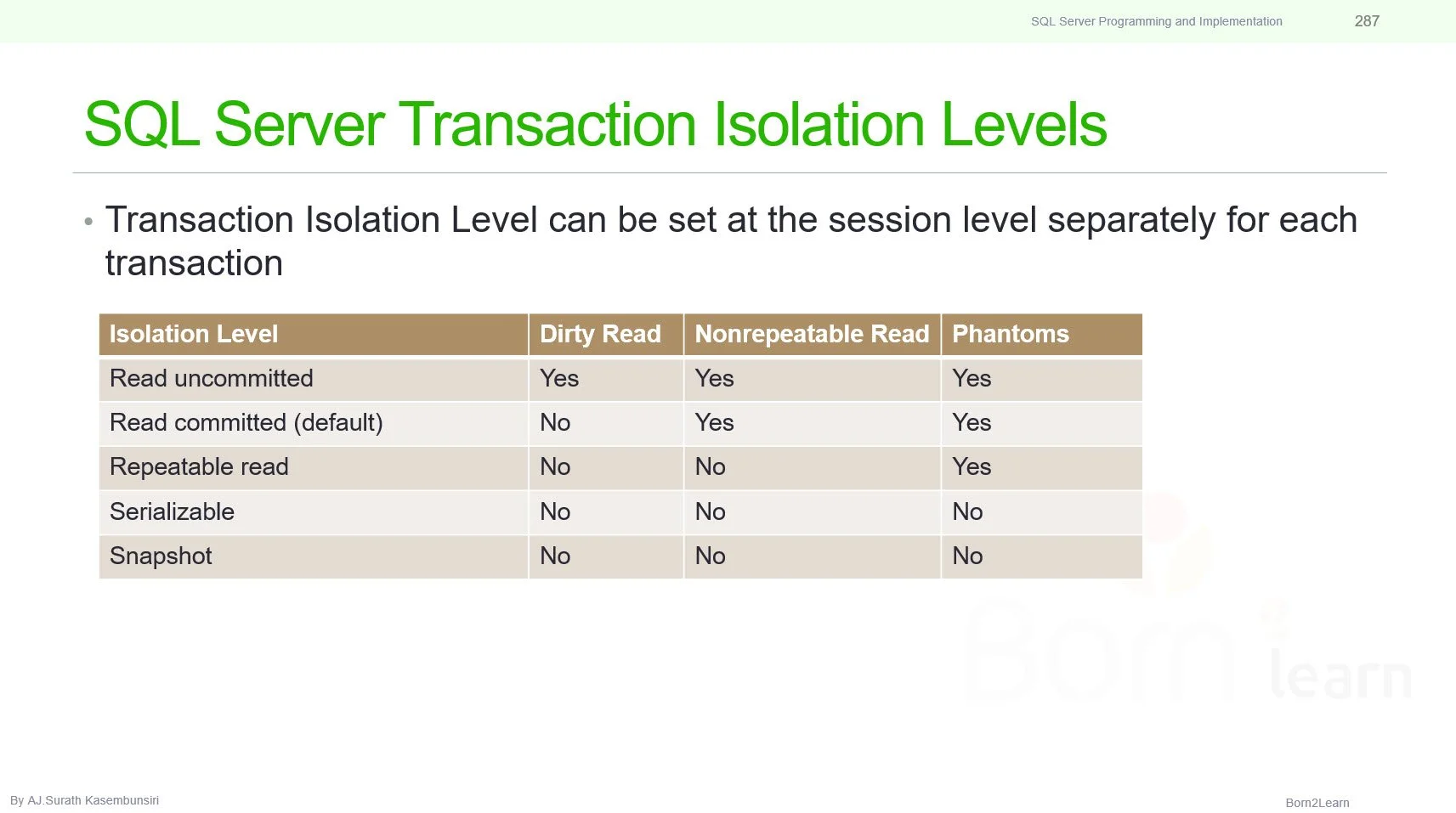Course: SQL Server Programming and Implementation








































หลักสูตรอบรม : SQL Server Programming and Implementation
(ครอบคลุม Version 2016-2022)
ระยะเวลา: 4 วัน (24 ชม.) 9.00 - 16.00 น.
ราคาอบรม/ท่าน : 12,500 บาท/15,000 บาท (Public Training with Online/Onsite)
กรณีเป็น In-house Training จะคำนวณราคาตามเงื่อนไขของงานอบรม
*ราคาดังกล่าวยังไม่รวมภาษีมูลค่าเพิ่ม*
Public Training หมายถึง การอบรมให้กับบุคคล/บริษัท ทั่วไป ที่มีความสนใจอบรมในวิชาเดียวกัน โดยจะมี 2 แบบ
1. อบรมแบบ Online โดย Live ผ่านโปรแกรม Zoom พร้อมทำ Workshop ร่วมกันกับวิทยากร
2. อบรมแบบ Onsite ณ ห้องอบรม ที่บริษัทจัดเตรียมไว้ พร้อมทำ Workshop ร่วมกันกับวิทยากร
หมายเหตุ: - ผู้อบรมต้องนำเครื่องส่วนตัวมาใช้อบรมด้วยตัวเอง
- วันอบรมที่ชัดเจนทางบริษัทจะแจ้งภายหลัง ตามเดือนที่ผู้อบรมแจ้งความประสงค์ไว้ (ทางบริษัทขอสงวนสิทธิ์การปรับเปลี่ยน ตามความเหมาะสม)
In-house Training หมายถึง การอบรมให้กับบริษัทของลูกค้าโดยตรง โดยใช้สถานที่ของลูกค้าที่จัดเตรียมไว้ หรือจะเป็นแบบ Online ก็ได้เช่นกัน และลูกค้าสามารถเลือกวันอบรมได้
ลงทะเบียนอบรมได้ที่
เน้นการทำ Workshop ที่ถูกออกแบบมาอย่างดีเยี่ยม, สนุกสนาน, ครบครัน เพื่อช่วยในการเรียนรู้และทำให้เกิดความเข้าใจได้อย่างง่ายดายที่สุด
#พร้อมเอกสาร lab และ source code #ทุกขั้นตอน
(ลิขสิทธิ์ โดย อ.สุรัตน์ เกษมบุญศิริ)
เนื้อหาต่างๆ มีการปรับเปลี่ยน/จัดหมวดหมู่ ใหม่ทั้งหมด เพื่อทำให้ง่ายต่อความเข้าใจ
การันตีครับ ว่า ผู้อบรมทุกคนที่จบจาก course นี้จะได้รับความรู้ทั้งภาคทฤษฏีและภาคปฏิบัติ อย่างครบถ้วน เพื่อนำไปใช้ในการทำงานจริง
📌เริ่มปูตั้งแต่พื้นฐาน skill set ของผู้เริ่มต้นงาน Developer กับ SQL Server
📌เข้าใจโครงสร้าง Database และการออกแบบที่เหมาะสมสำหรับงาน Dev รวมไปถึงการต่อยอดเข้าสู่ระบบ Production
📌รู้จักและเลือกใช้งาน Data Types ได้อย่างเหมาะสม
📌การประยุกต์ใช้งาน Table และ Partition Table ที่สามารถเก็บข้อมูลขนาดใหญ่ในระดับ Enterprise ได้อย่างเต็มประสิทธิภาพ
📌การสร้างและเลือกใช้ Indexes ที่เหมาะสม สำหรับการทำงาน query แต่ละประเภท เพื่อความเร็วในการออก report
📌การจัดการระบบความถูกต้องของข้อมูล ด้วย Constraints แบบต่างๆ
📌เทคนิคการเขียน Database Trigger เพื่อช่วยในงานระบบ Audit และ Data Integrity
📌การประยุกต์ใช้ Views เพื่อออก report ที่เหมาะสม
📌ความเข้าใจเกี่ยวกับ Store Procedures ในแนวทางที่ Dev ควรรู้และนำไปใช้ในการเขียน program ที่ได้ประโยชน์สูงสุด
📌เทคนิคการเขียน Store Procedure เพื่อช่วยในด้าน Performance, Secure และ Reusable พร้อมให้ App นำไปเรียกใช้งาน
📌การสร้างชุดคำสั่งแบบ Function เพื่อเป็นตัวช่วยในการเขียน program เพื่อให้ได้ประสิทธิภาพอย่างเต็มที่
📌ความเข้าใจในเรื่อง Transaction and Locks ที่เกิดจากการเข้าใช้งานพร้อมกันจาก App และเป็นสาเหตุสำคัญเรื่องหนึ่งของความล่าช้า
📌Best Practice สำหรับการเขียน SQL เพื่อหลีกเลี่ยงการ Lock และทำให้ App ทำงานได้รวดเร็วขึ้น
📌workshop ตลอดการฝึกอบรม โดย lab practice ที่มีคุณภาพและทำให้กลมกล่อม เข้าใจง่าย โดย อ.สุรัตน์
📌มาร่วมเรียนรู้กับการ Dev และ Implement บน SQL Server แบบมืออาชีพ กับ Born2Learn
วิทยากร:
อ.สุรัตน์ เกษมบุญศิริ
ผู้เชี่ยวชาญและวิทยากรที่มีประสบการณ์มากกว่า 20 ปีในวงการ
พร้อมด้วยใบรับรองจากบริษัทระดับโลกมากมาย อาทิเช่น Microsoft, CompTIA, ITIL, Cisco และอื่นๆ
หลักการและเหตุผล:
This course provides the knowledge and skills to develop and implement a Microsoft SQL Server database. The course focuses on teaching individuals how to use SQL Server product features and tools related to implementing a database.
หลักสูตรนี้เหมาะสำหรับ:
This course is intended for IT Professionals who want to become skilled on SQL Server product features and technologies for implementing a database. To be successful in this course, the student should have knowledge of basic relational database concepts and writing T-SQL queries.
วัตถุประสงค์ของหลักสูตร:
After completing this course, students will be able to
· Create databases and database files.
· Determine appropriate data types when designing table, covert data between data types, and create alias data types.
· Be aware of good design practices regarding SQL Server tables and be able to create tables using T-SQL.
· Determine appropriate single column and composite indexes strategies.
· Create tables as heaps and tables with clustered indexes. Also consider the design of a table and suggest an appropriate structure.
· Design effective non-clustered indexes.
· Implement PRIMARY KEY, FOREIGN KEY, DEFAULT, CHECK and UNIQUE constraints, and investigate cascading FOREIGN KEY constraints.
· Design and implement DML triggers
· Design and implement views
· Design and implement stored procedures.
· Use both traditional T-SQL error handling code and structured exception handling.
· Design and implement functions, both scalar and table-valued. (Also describe where they can lead to performance issues).Implement managed code in the database.
· Perform basic investigation of a deadlock situation and learn how transaction isolation levels affect application concurrency.
ความรู้พื้นฐาน:
· Basic knowledge of the Microsoft Windows operating system and its core functionality.
· Working knowledge of Transact-SQL.
· Working knowledge of relational databases.
· Some experience with database design
เนื้อหาหลักสูตร:
Module 1: Creating Databases and Database Files
Creating Databases
Creating Filegroups
Creating Schemas
Creating Database Snapshots
Module 2: Working with Data Types and Tables
Using Data Types
Understanding Collations
Converting Data Types
Work with Specialized Data Types
Creating and Altering Tables
Surrogate Keys vs. Sequence
Temporary Tables
Compute Columns
Creating Partitioned Tables for heavily table
Using Switch, Merge and Split
Module 3: Implementing Indexes
The Need for Indexes
Table Scan vs. Index Scan
About Heap
Implementing Clustered Indexes
Primary key and Clustering key
How to choose Clustering key
Implementing NonClustered Indexes
Consideration Data Types and Indexes
About Execution Plan
Implementing Columnstore Indexes
Maintenance Index with Rebuild and Reorganize
Fill factor and Pad Index
Index Statistics concept
Why need to update Index Statistics
Optimizing Indexes
Module 4: Ensuring Data Integrity through Constraints
Enforcing Data Integrity
Implementing Rules1
Implementing Default
Implementing CHECK
Implementing FOREIGN KEY
Implementing NULL
Implementing DDL Triggers
Implementing DML Triggers
Module 5: Implementing Views
Introduction to Views
Advantages of Views
Types of Views
Implementing Standard Views
About Updatable Views
Obfuscating View definitions
Nested Views consideration
Implementing Partition Views
Implementing Indexes Views
Module 6: Implementing Stored Procedures
Introduction to Stored Procedures1
Benefit of Store Procedures
Working with Store Procedures
Guideline for Creating Store Procedures
How to encrypt Store Procedures
Implementing Parameterized Store Procedures
About Parameter Sniffing and Performance impact
Why we need recompile Store Procedures
Controlling Execution Context
How to raising error in Store Procedures
Implementing Exception Handling in Store Procedures
Module 7: Implementing User-Defined Functions
Overview of Functions
About System Functions
Implementing Scalar Functions
Deterministic vs. Non-deterministic Functions
Implementing Table-valued Functions (TVF)
Inline Table vs. Multi-statement Table-valued Functions
Controlling execute context
Guideline for Creating Functions
How to choose TVF vs. Stored Procedures
How to choose TVF vs. Views
Module 8: Creating Highly Concurrent SQL Server Applications
What are Transactions
Designing for Concurrency
Controlling Transactions
Auto-Commit Transactions
Explicit Transactions
Implicit Transactions
About XACT_ABORT
Consideration for Using Transactions
Management of Locking
Method to View Locking Information
Types of Locks
About Concurrency problems
Transaction Isolation Levels concept
Implementing Read Uncommitted
Implementing Read Committed
Implementing Repeatable Read
Implementing Serializable
Implementing Snapshot

